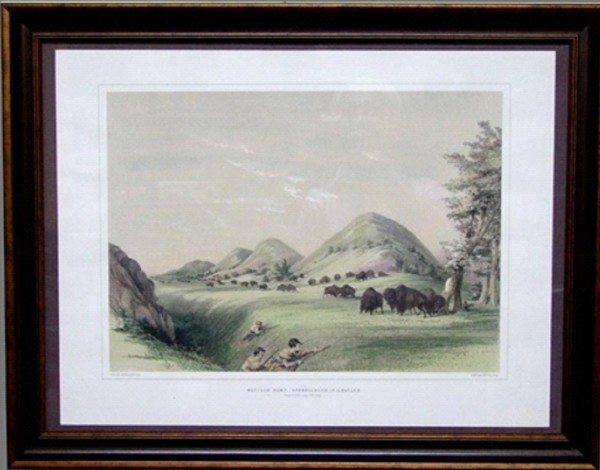-
Artist: George Catlin (American, 1796-1872)
“George Catlin, (born July 26, 1796, Wilkes-Barre, Pennsylvania, U.S.—died December 23, 1872, Jersey City, New Jersey), American artist and author, whose paintings of Native American scenes constitute an invaluable record of Native American culture in the 19th century” (1).
“Catlin was just seven years old in 1803 when Thomas Jefferson sent Lewis and Clark on a three-year expedition to explore the newly acquired Louisiana Purchase” (2).
“When Catlin was 8 years old, his mother had been captured by Indians. Therefore, his early life was influenced by family legends and frontier guests. He was educated at home, was outdoors oriented, and collected Indian relics. In 1817, he began studying law in Litchfield, Connecticut and at the same time teaching himself to paint portraits. He practiced law in Luzerne, Pennsylvania until 1823 when he moved to Philadelphia to devote himself to portrait painting, as a friend of Rembrandt Peale, Thomas Sully, and John Neagle. His portraits up to 1829 included New York and Washington politicians. His Constitutional Convention painting in 1829 contained 115 figures” (3).
“He studied at the Pennsylvania Academy of Fine Art* and then went to New York to the National Academy of Design*, where in 1824, he was also elected a Member. In Philadelphia in 1824, he had seen a delegation of Plains Indians, described as "lords of the forest," which aroused his determination to become a pictorial historian of Indians. In the six years before he headed West, he painted portraits of Indians on reservations in western New York” (3).
“When Catlin first traveled west in 1830, the United States Congress had just passed the Indian Removal Act, requiring Indians in the Southeast to resettle west of the Mississippi River. This vast forced migration—as well as smallpox epidemics and continuing incursions from trappers, miners, explorers, and settlers—created pressures on Indian cultures to adapt or perish. Seeing the devastation of many tribes, Catlin came to regard the frontier as a region of corruption. He portrayed the nobility of these still-sovereign peoples, but he was aware that he painted in sovereignty's twilight” (4).
“Not merely a painter, Catlin also considered himself a scientist, explorer, author, and entrepreneur. While touring with his Gallery, he fell so deeply into debt that he lost almost the entire collection. His compulsion to continue was so strong he re-created more than 400 paintings and undertook further travels to paint 200 additional images covering North and South America” (2).
“Catlin's dream was to sell his Indian Gallery to the U.S. government so that his life's work would be preserved intact. His continued attempts to persuade various officials in Washington, D.C. failed. He was forced to sell the original Indian Gallery, now 607 paintings, due to personal debts in 1852. Industrialist Joseph Harrison took possession of the paintings and artifacts, which he stored in a factory in Philadelphia, as security. Catlin spent the last 20 years of his life trying to re-create his collection. This second collection of paintings is known as the "Cartoon Collection" since the works are based on the outlines he drew of the works from the 1830s” (5).
“Though he did not live to see his wish fulfilled, the original Indian Gallery came to the Smithsonian seven years after his death in 1872” (2).
“The bulk of Catlin’s collection of works, which is mainly of ethnographic and historical interest, was acquired by the Smithsonian Institution in 1879. His other published works include Catlin’s North American Indian Portfolio: Hunting Scenes and Amusements of the Rocky Mountains and Prairies of America (1845), Catlin’s Notes of Eight Years’ Travels and Residence in Europe (1848), Life Amongst the Indians (1867), and Last Rambles Amongst the Indians of the Rocky Mountains and the Andes (1867)” (1).
Reference:
1.
The Editors of Encyclopedia Britannica. George Catlin: American artist and author [internet]. [updated 2014 July 24; cited 2015 June 8]. Available from: http://www.britannica.com/EBchecked/topic/99958/George-Catlin
2.
Dippie, BW. George Catlin [internet]. Washington, D.C.: Smithsonian American Art Museum in association with W.W. Norton & Company; 2002. [cited 2015 June 8]. Available from: http://www.americanart.si.edu/collections/search/artist/?ID=782
3.
Askart Staff. George Catlin [internet]. [cited 2015 June 8]. Available from: http://www.askart.com/artist_bio/George_Catlin/4575/George_Catlin.aspx
4.
American Art Staff. Catlin Virtual Exhibition [internet]. [cited 2015 June 8]. Available from: http://www.americanart.si.edu/catlin/highlights.html
5.
George Catlin Biography [internet]. 2002 [updated 2015; cited 2015 June 8].
